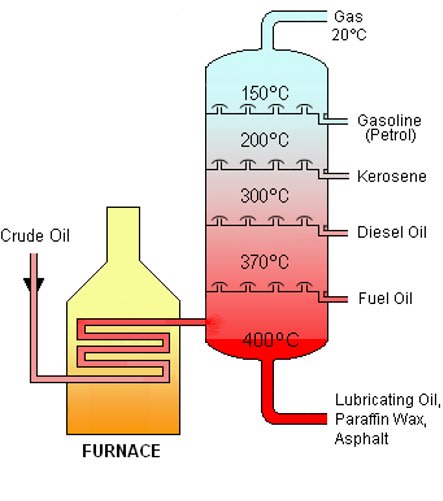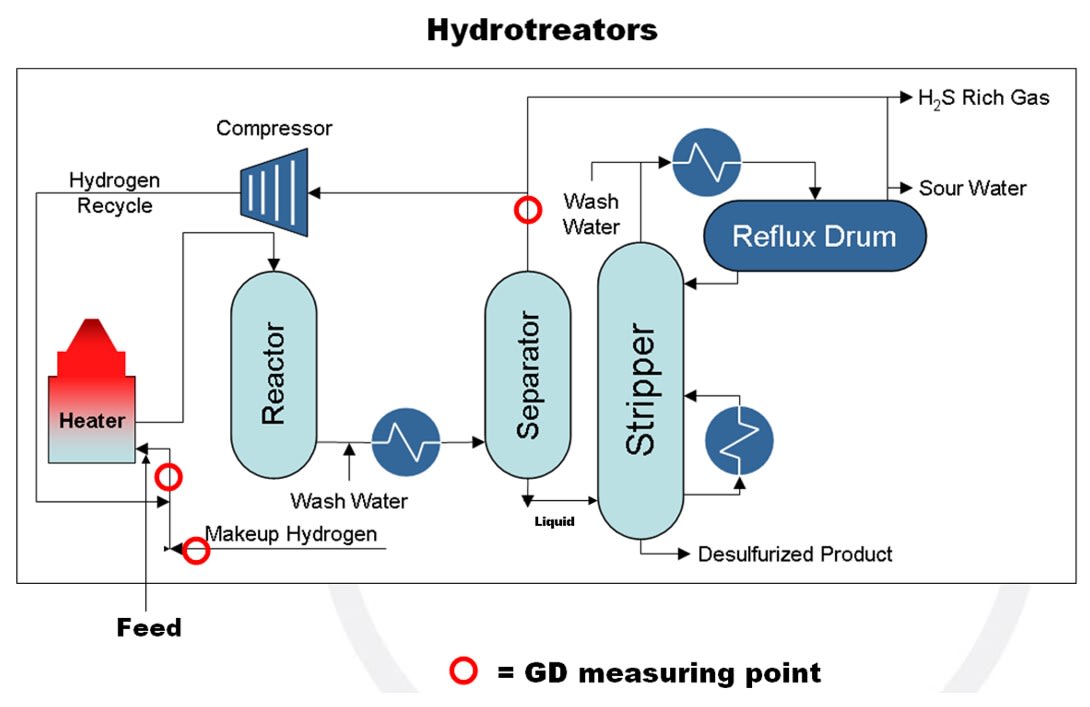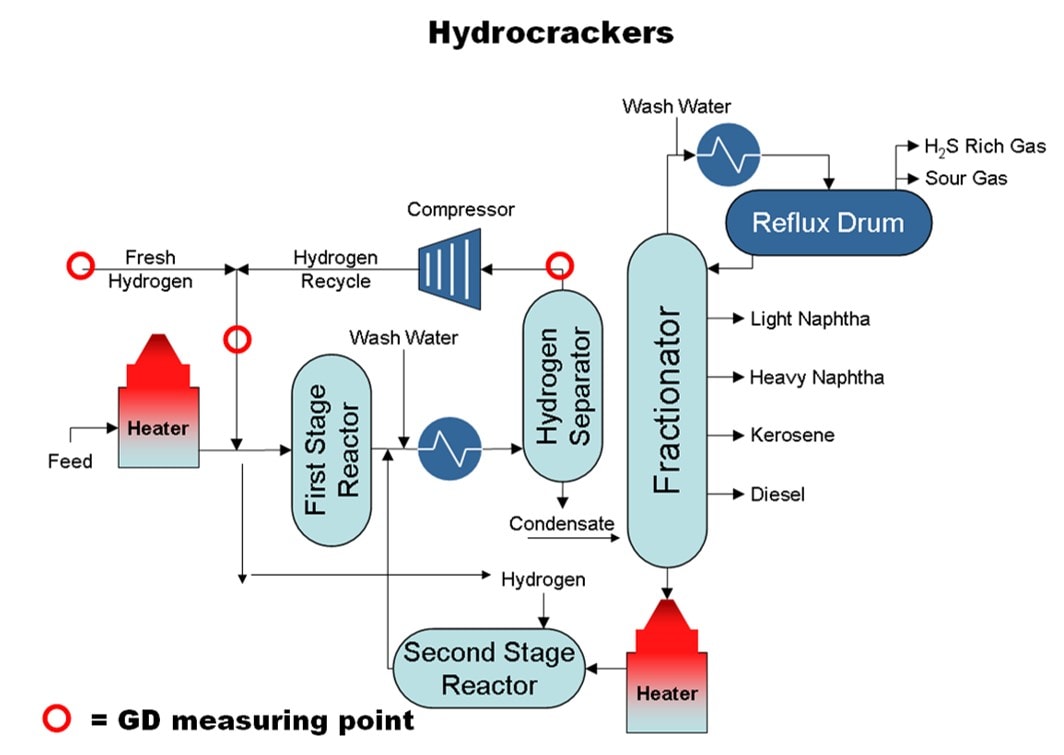Accurate Measurements Enable Efficient Process Control
Plant Name: LP Gas Producer
Industry: Refining
Product(s): (LPG) Liquified Petroleum Gas
Application
The U.S. refineries represent approximately 23 percent of the world's petroleum production, and the United States has the largest refining capacity in the world. Petroleum refining is an industry, which is undergoing intense amounts of scrutiny in the United States from regulatory agencies and environmental groups. As a result, releases of pollutants caused by corrosion leaks are considered high consequence events. The Clean Air Act of 1990 has forced refiners to implement several costly measures to reduce their impact on the environment, both with the types of products they produce and how they operate their refineries.
An oil refinery is an industrial process plant where crude oil is processed and refined into petroleum products, such as gasoline, diesel fuel, asphalt base, heating oil, kerosene, and liquefied petroleum gas. The measurement of hydrogen purity throughout a system allows for efficient process control.
 Gas density can be measured in various stages during petroleum refining.
Gas density can be measured in various stages during petroleum refining.
i.) Hydrotreating
ii.) Catalytic Reformer
iii.) Input Hydrogen Purity
iv.) Catalytic Hydrocracking
v.) Recycled Hydrogen
vi.) Fuel Gas Specific Gravity
vii.) Hydrogen Purification
viii.) Off Gas Specific Gravity
Process
Step One: Hydrotreating is a process in which the hydrotreators or HDS (hydrodesulfurization) units remove sulfur from distillation products like Naphtha, Diesel, and Gas Oils before reforming or hydrocracking process. This “sweetening” process reduces SO2 emissions when the product is burned and protects the catalysts used in downstream units such as reformers. The hydrotreating process is carried out in the presence of hydrogen to saturate the cleaned hydrocarbons. Hydrogen is consumed during the process, and the purity of the hydrogen present will affect the performance of the reactions. Many of the same parameters exist for the hydrotreater as for the hydrocracker.
The feed is mixed with hydrogen, heated to 300-400 degrees Celsius, and pressurized up to 1900 psi. This mixture flows to a reactor containing a fixed bed of catalyst (typically alumina-based impregnated with cobalt and molybdenum).

Step Two: Catalytic reformers convert sweetened naphtha with low octane ratings into high octane rating Reformate. This is done by “reforming” the straight-chain feed molecules into branched and cyclic molecules. The feedstock mixes with hydrogen, pressurized, and heated. This mixture proceeds to a series of reactors containing a catalyst such as platinum, where the reforming occurs. Due to the dehydrogenation of straight-chain molecules, the products of this process are high-octane reformate and hydrogen-rich gas.

Step Three: Gasification is a process that converts carbonaceous materials, such as coal, petroleum, or biomass, into carbon monoxide. Hydrogasification is a process that converts carbonaceous materials into carbon monoxide and hydrogen by reacting the raw material with a controlled amount of oxygen at a high temperature. The resulting gas mixture is called synthesis gas or syngas and is itself a fuel.
From the perspective of a reformer or hydrocracker, there is value in knowing the hydrogen purity from the supplier. Checking for air in leakage or other contaminates could save money and lives.
Step Four: In catalytic hydrocracking, the hydrocrackers break heavy, long-chain oil molecules into shorter, lighter, more valuable molecules. This process is called cracking, whereby complex organic molecules such as kerogens or heavy hydrocarbons are broken down into simpler molecules by breaking carbon-carbon bonds in the precursors. The saturation of hydrogen follows the broken bonds. The cracking rate depends on temperature and the presence of any catalysts.
Hydrocracker products are sulfur-free and saturated. A typical feedstock is coker gas oil and gas oils from crude oil distillation. The feedstock is mixed with hydrogen, pressurized (2000 psi), and heated (425°C). This mixture flows to a reactor containing a catalyst, typically platinum, where the cracking takes place. The hydrogen-rich gas is then separated from the cracked product, which is further fractionated.
Hydrocracker units can be configured into single-stage or two-stage reactor systems that enable a higher conversion of gas oil into lower boiling point material. Distillates from hydrocracking make excellent jet fuel blend stocks. The yield across a hydrocracker may exhibit gains as high as 25%, making it a substantial contributor to refinery profitability.

Step Five: Recycled hydrogen is the exit gas produced by a reformer or left after hydrocracking contains condensable hydrocarbons with about 75% to 90% hydrogen. Some of this mixture is recycled into the process to minimize the use of pure hydrogen and reduce cost. The purity of the exiting hydrogen also represents the production efficacy as the hydrogen purity will change as process conditions change, reaction catalysts are contaminated, or gas/liquid separators fill. The recycled hydrogen purity measurement allows more efficient control of pure/recycled hydrogen and a low-cost, low-maintenance way to monitor real-time hydrogen production performance in the process.
Step Six: Fuel gas and excess hydrogen are used as a burner fuel to heat the process heaters and onsite power boilers. The specific gravity of the fuel gas is used to calculate the burner rate. Knowledge of the specific gravity of the fuel allows a more efficient mixing of fuel gases and a better burner efficiency, which reduces costs.
Step Seven: Many refinery units require or produce hydrogen, and the purity of this hydrogen is essential to the efficiency of the plant. A gas purity measurement before and after the cleaning (absorption) or separation stage of hydrogen recycling can allow accurate determination of the efficiency of the cleaning stage. Recycled gas containing mostly hydrogen can be purified to supplement the recycled gas “loop.” Among the many methods employed are membrane and PSA technologies.
Contaminates in the post-cleaning process stream indicate a deterioration of the process parameters. For example, the separator is full, or the membrane or catalysts are contaminated. This information is valuable in preventative maintenance schedules or troubleshooting batch problems.
Step Eight: The specific gravity of the off-gas determines the hydrogen content. The specific gravity value on the off-gas shows hydrogen slip in the process
Challenges
LPG heating value control involves vaporizing LPG and mixing it with air to obtain a gas with the same heating value as natural gas. The GD402 can measure the heating value indirectly through its correlation with the density and specific gravity of the mixed gas. The relationship between specific gravity and the SNG mixture is well documented and used for process control. Since there will be some variation in the composition of the various SNGs from lot to lot, the SNG density and specific gravity are premeasured. The computational parameter data of the analyzer is based on that to minimize the error due to the composition variation.

Solution
Utilizing the Model GD402 gas density converter and Model GD40 detector will provide continuous measurement of gas density and several other valuable parameters, including specific gravity and molecular weight. The GD40 detector is designed for intrinsically safe and explosion-proof, explosion-protected applications. It is designed to be virtually maintenance-free and minimizes costs.
Key Advantages
• Continuous, highly responsive, sensitive measurements of gas density and several other valuable parameters, including specific gravity and molecular weight, improve operating efficiency and plant safety.
• Two-wire connections between the detector and converter minimize installation costs.
• Only routine maintenance is required; for example, once every three months, depending on the application
• Configuration can be performed locally via the front panel or remotely using the optional “Brain” terminal.
* For further assistance, please contact the Yokogawa Analytical Marketing Department.
Industries
-
Oil & Gas
Yokogawa has a wealth of experience in every part of the oil and gas business, from offshore and onshore facilities to pipelines, terminals, and deepwater operations. We provide solutions that enhance safety, ensure accurate and reliable operation, and increase plant efficiency.
-
Refining
In the ever-changing marketplace, refineries are seen not only as crude processing units but also as profit centers. At the same time, there is a keen awareness of the need for safety at such facilities. A total production solution that encompasses planning, scheduling, management, and control is required to achieve long-term goals for profitability, efficiency, and environmental protection. With years of expertise in the automation field, Yokogawa can bring you affordable total solutions for improved operability and a cleaner world.
Related Products & Solutions
-
GD402/GD40 Gas Density Analyzer
The GD402 gas density analyzer and GD40 gas density detector provide continuous measurement of gas density as well as other valuable parameters, including specific gravity and percent concentration.
-
Gas Analyzers
- Gas analyzers
- Real-time gas analysis
- Enhances efficiency, safety, throughput, product quality
- Ensures environmental compliance
-
Measurement
With its highly reliable measurement technology, Yokogawa is able to offer an extensive lineup of product solutions that deliver new value to our customers by bringing together operational technology (OT) and information technology (IT).
Have Questions?
Contact a Yokogawa Expert to learn how we can help you solve your challenges.